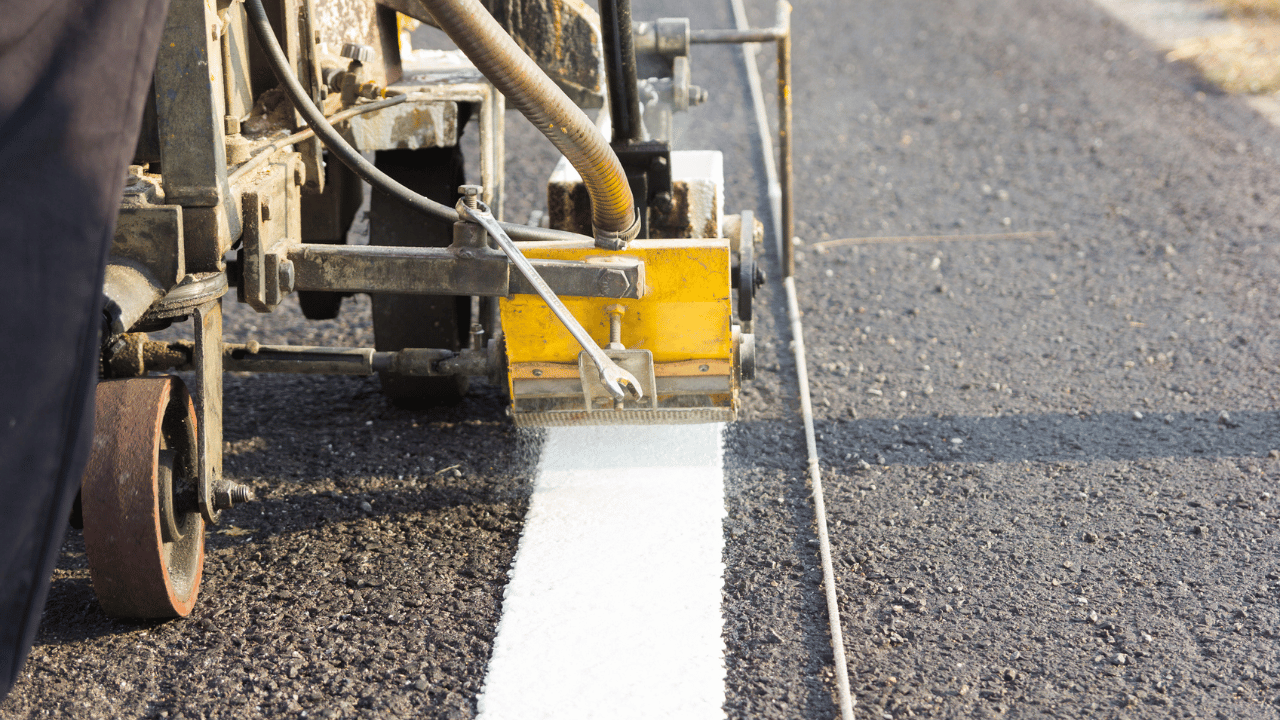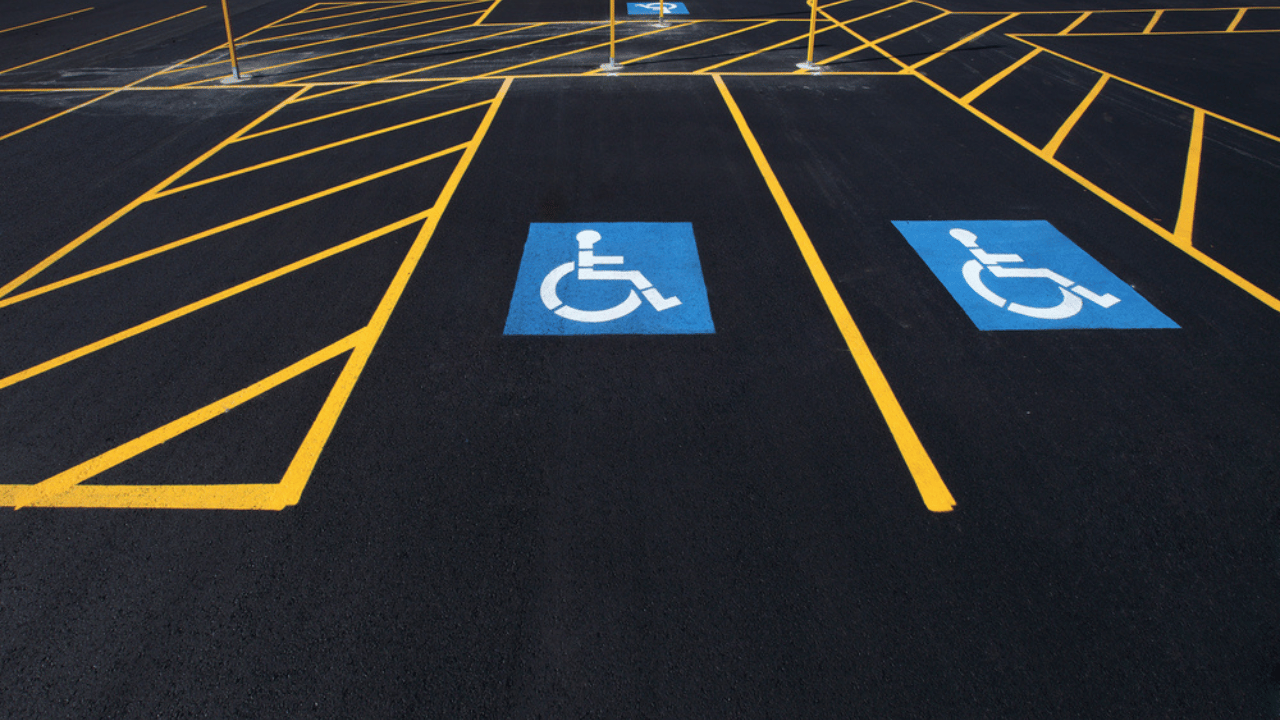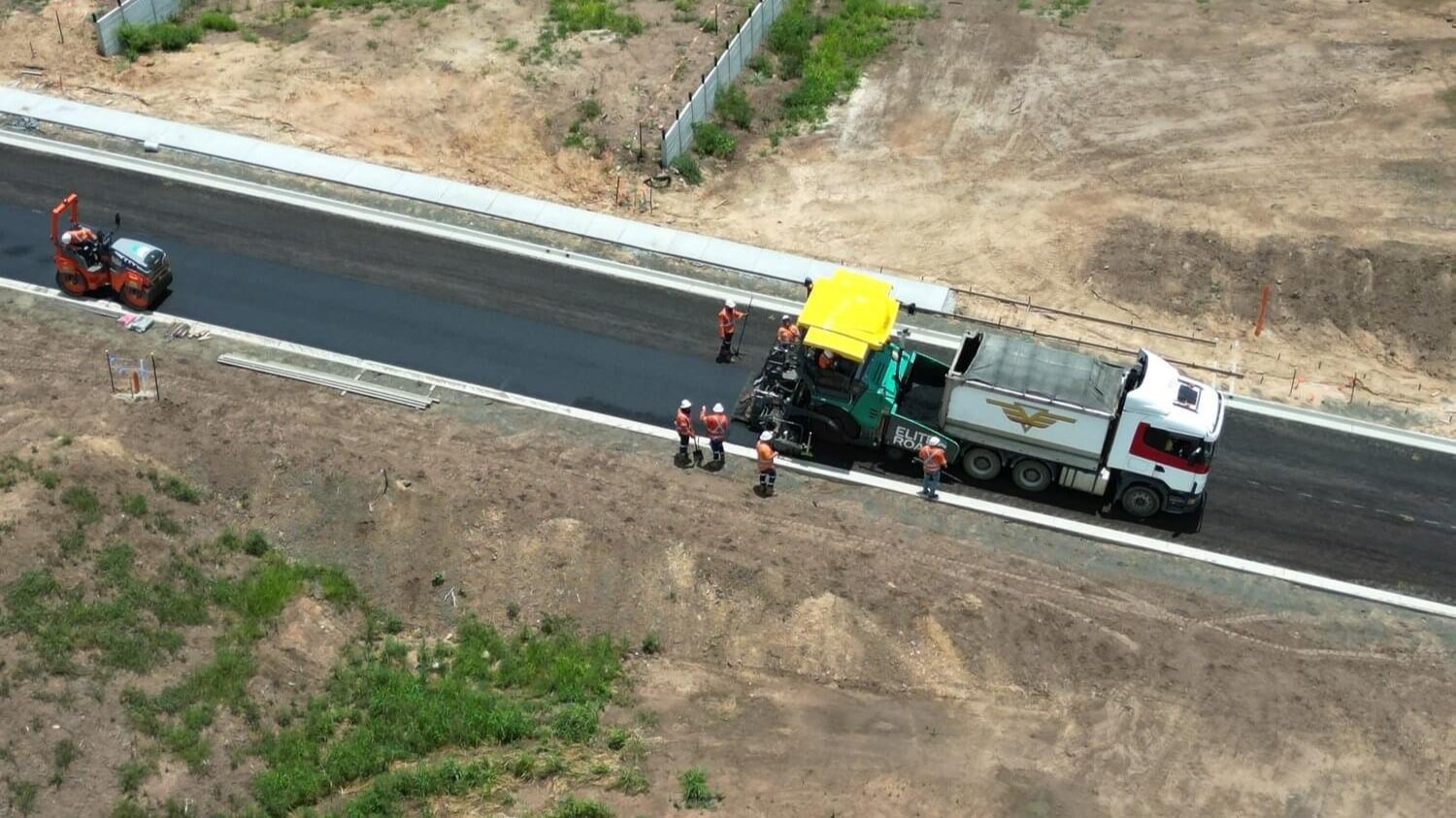How Do They Paint Lines on the Road? A Complete Guide to Road Markings
Have you ever driven down a freshly marked highway and wondered how those crisp, perfectly straight lines got there? Road markings are something most drivers take for granted and don't realise that they're actually fundamental to road safety and traffic flow.
Whether they're solid lines that prohibit overtaking, dashed lines that indicate when lane changes are safe, or the bold white stripes of pedestrian crossings, road markings make the difference between confusion and clarity on our streets. They're much more than just paint slapped onto asphalt, they're essential safety features that help direct millions of drivers every day.
At Elite Roads, we take road safety seriously and ensure that every project meets the highest standards of quality and precision. This guide takes you behind the scenes of professional road marking, and details exactly how expert crews transform bare pavement into clearly defined and safely marked roadways.
The Critical Role of Road Markings
Before diving into the specifics of how lines are painted, it's important to understand why road line markings matter so much. These surface markings are the silent language of our roadways, communicating essential information to drivers, pedestrians and cyclists, through lines and symbols instead of words.
Road markings guide drivers through complex intersections, indicate where changing lanes is permitted, define traffic lanes on busy highways and mark pedestrian crossings for safety. They need to be clearly visible during the day and at night, and in all weather conditions, which is why the proper application of these markings requires both precision and expertise.
What Do They Use to Paint Lines on Roads?
Although you might at first picture road lines being painted by someone with a paintbrush or simple spray equipment, the process is actually far more sophisticated. Water-based paints were once the go-to option, but the road marking process has evolved significantly over the past few decades.
Today's professionals primarily use something called 'thermoplastic road marking paint', which is a material that has revolutionised how we apply road marking paint. Unlike conventional paint that sits on top of the road surface, thermoplastic resin bonds with the pavement, creating markings that can withstand heavy traffic, weather conditions and last significantly longer.
The mix usually includes something called 'titanium dioxide', which gives the paint its bright white colour and helps it reflect light during the day and at night. Other ingredients are also added to make the markings tough and long-lasting. Yellow lines use different pigments, but they are applied in basically the same way, creating the clear colour system that helps keep traffic organised and safe.
Traditional Road Paint vs Modern Thermoplastic Materials
Traditional road paint still works well on smaller roads and car parks, but when it comes to major roads and high-traffic areas, thermoplastic paint is a much better option. Did you know that thermoplastic systems last three to five times longer than conventional paints?! That's a massive difference when considering busy highways.
Water based paints also work well for temporary markings and on quieter streets, but they just can't keep up with the heavy wear that thermoplastic materials can handle. While thermoplastic markings require a higher upfront investment, they last much longer, staying bright and visible through changing weather and heavy traffic, and ultimately help keep roads safer for everyone.
The Equipment: Dedicated Road Marking Vehicle Technology
A dedicated road marking vehicle is a very impressive piece of equipment! These specialised trucks carry everything needed to lay down precise and consistent road surface markings across kilometres of roadway. When compared to the simple hand-operated line stripers used decades ago, it's amazing to see just how far the technology has come.
Today's road marking machines come equipped with heating systems that keep thermoplastic materials at exactly the right temperature for application. These dedicated road vehicles can hold hundreds of litres of material, which means crews can keep working without needing to constantly stop to refill.
How Road Striping Works: The Spray Gun System
At the core of any road marking machine is the spray gun, which applies the paint or material onto the road. The number of spray guns depends on how wide the line needs to be. One gun is generally enough for standard lines, while two or more may be used for wider markings.
In many modern machines, the spray guns are controlled by a computer. This helps keep the amount of material and the thickness of each line consistent. Getting that thickness just right is important, because if it's too thin, the lines fade quickly, and if it's too thick, extra material is wasted and the markings can stick up too high from the road.
How Do They Paint Road Lines So Straight?
This is the question everyone asks when they see perfectly straight white lines stretching into the distance on a highway. The answer? It's a combination of old-school surveying techniques and modern technology working together.
Before any marking begins, the route gets carefully planned using a surveyed line as the reference point. Highly skilled operators work alongside survey crews to establish exactly where each line should go, taking into account road geometry, sight lines and safety requirements.
Once the path is set, modern road marking machines use computer control systems that link to these surveyed points. Some advanced systems even use GPS technology, which lets the marking machine follow a predetermined path with pinpoint accuracy. The operator's main job then becomes monitoring the system and ensuring that the material is applied evenly, rather than manually steering the line.
For a straight road, mechanical guides attached to the road marking vehicle help maintain a consistent distance from the road edge or centre line. This keeps traffic lanes uniform in width from start to finish.
The Process of Applying Road Line Markings
Understanding how road striping works means looking at the complete process from start to finish. There's a lot more to it than just driving down the road whilst spraying paint. Professional road surface marking follows a systematic approach that ensures quality results.
Surface Preparation
Before any road marking paint touches the pavement, the road surface needs to be looked over and properly prepared. Loose debris, dirt, oil and old worn markings have to be removed or dealt with. The surface has to be dry, as moisture stops thermoplastic materials from bonding properly. Weather conditions also play an important role, as temperature, humidity and upcoming forecasts, all influence when marking work can take place.
Heating the Material
For thermoplastic road marking systems, the material needs to be heated to the right temperature before it can be applied. This is where the specialised equipment on a dedicated road marking vehicle really proves its worth. The thermoplastic resin has to reach a molten state, while at the same time not get too hot, as that damages its properties.
Application at the Right Pace
To apply the road lines, the road marking vehicle moves at a carefully controlled speed. Accidentally going too fast can mean that the lines are painted too thinly or patchy, and going too slowly can create puddles or lines that are too thick.
For solid lines, the spray guns run continuously as the vehicle moves forward. For dashed lines or skip lines, the system automatically switches on and off to create the pattern that tells road users that they can overtake when it's safe. Double lines generally need two passes, or specialised equipment that can lay down both solid lines at once.
Adding Reflective Glass Beads
One important part of road marking that many people aren't aware of involves the use of tiny glass beads. As the thermoplastic paint is applied, these reflective beads are spread over the still-molten surface. They settle slightly into the material and create thousands of miniature reflective points.
When headlights shine on these beads at night, the light bounces straight back towards the driver, making the line markings clearly visible, even in complete darkness. This is known as 'retroreflectivity', and is a modern and innovative technique that helps road markings stay bright and easy to see in all lighting conditions.
Types of Road Markings and Their Purposes
Not all lines serve the same purpose, and understanding the different types helps explain why road marking professionals need such versatile equipment and materials.
Centre Line and Lane Dividers
The centre line on a two-lane road separates vehicles travelling in opposite directions. On multi-lane highways, lane markings divide the traffic moving in the same direction. These lines are usually white in most countries, although some places use different colours.
A solid line means you must not cross, while a broken line allows overtaking when it's safe to do so. Two solid lines indicate no crossing in either direction, and these are usually found on bends or hills where visibility is limited.
Edge Lines and Boundaries
White lines along the outer edges of traffic lanes help drivers stay in the right position, which is especially important at night or in poor weather. On major roads, these lines also show the usable roadway width and guide drivers away from shoulders or dangerous drop-offs.
Stop Lines and Pedestrian Crossings
Stop lines show drivers exactly where they need to stop at the lights or at a stop sign, while pedestrian crossings use those familiar ladder bars or zebra stripes to show where people have the right of way. As they’re in busy spots and get a lot of wear, these markings need a bit more attention and regular repainting to stay clear and visible.
Yellow Lines for Parking and Special Zones
Yellow road markings can serve several purposes but generally indicate parking restrictions or special zones. Single or double yellow lines along the kerb show when stopping or parking is not permitted. The use of colour and pattern gives drivers quick, easy-to-understand information about what's allowed in each area.
Specialty Markings
Car parks, bus lanes, bike paths and other special areas, all rely on unique surface markings to guide drivers and pedestrians. Arrows show which way you can turn, words like "STOP" or "SLOW" give clear instructions, and symbols help communicate important messages. Modern road marking machines are designed to apply all these different markings with precision, so that roads are kept organised, safe and easy to navigate.
Precision and Quality Control in Road Line Markings
The secret to painting perfectly straight road lines comes down to a mix of technology, training and quality control. At Elite Roads, we invest heavily in all three because true precision isn't just about having the right equipment, it's about having the skilled people and proven processes to use it effectively.
The Role of Computer Control
Modern line marking machines use advanced computer systems to manage several factors at once. These systems automatically monitor and adjust things like:
Material temperature and flow rate
Vehicle speed and position
Line width and thickness
Application patterns for dashed lines
Glass bead distribution rates
This technology doesn't replace skilled operators, but instead helps them keep the quality consistent over long stretches of road.
Laying Pram and Manual Operations
Not every job calls for a large road marking truck. In places like car parks, tight intersections, or smaller streets, crews often use compact machines or even apply markings by hand. A 'laying pram' is a small and hand-guided line marker that allows operators to paint precise lines in confined areas, all while still keeping the quality high.
These smaller jobs actually demand even more skill. Without the automated guides and systems found on larger machines, operators rely on their experience and steady hands to keep every line straight and consistent.
Is Road Marking Paint Toxic to Humans?
This is an important safety question for both road marking crews and the public. The good news is that modern road marking materials have come a long way in terms of health and environmental safety.
Water based paints used for line marking are low in volatile organic compounds (VOCs) and pose very little risk once they've dried. During application, workers use ventilation and protective gear to stay safe, but once the paint sets, it's harmless to drivers and pedestrians.
Thermoplastic road marking materials are also made with safety in mind. The material is applied at high temperatures, so proper training and protective equipment are essential for crews. However, once it cools, the finished surface is completely stable and safe. The ingredients, like thermoplastic resin and titanium dioxide pigment, are used because they don't release harmful substances and remain durable in all weather conditions.
Professional road marking teams also follow strict safety protocols. Crews wear the right protective gear, work in well-ventilated areas and follow handling guidelines set by manufacturers and safety regulators. Operators are thoroughly trained in application techniques, as well as in safe material handling to ensure that every job is completed safely and responsibly.
Environmental Conditions and Their Impact
Getting road surface marking right depends heavily on the weather. Temperature, humidity and precipitation all play a role in how materials bond to the pavement and how quickly they cure.
Thermoplastic materials are particularly fussy about temperature. Both the air and the road surface need to be above certain minimum temperatures for proper application. If it's too cold, the materials won't bond properly, and if it's too hot, they can flow or sag before setting. This is why experienced operators keep a close eye on surface temperatures throughout the day.
Rain or moisture is one of the biggest challenges. Water prevents the thermoplastic paint from bonding correctly and can lead to premature failure of the markings. Even morning dew can interfere with proper adhesion, and so professional contractors usually have to watch weather forecasts closely and work during overnight hours, as that's when traffic is lighter and when conditions are more predictable. The timing of road marking work isn't just about convenience, it's also crucial for getting results that last.
The Difference Between Major Roads and Smaller Roads
The approach to road marking changes quite a bit depending on the type of road. Major roads with heavy traffic need the most durable materials and precise application, which is why thermoplastic road systems are generally the go-to choice for these jobs.
When marking major highways and arterial roads for example, the higher upfront cost of thermoplastic materials makes sense here because they don't need to be remarked as often. On a busy highway, shutting down lanes for maintenance is both expensive and disruptive, so markings that last longer are worth their weight in gold. The investment pays off through less frequent maintenance and more importantly, improved safety.
Smaller roads and local streets still often use traditional road paint, especially in areas with lighter traffic where the markings don't cop as much wear. Choosing the right material and application method means weighing up initial costs, how long they'll last, traffic volumes and maintenance budgets. What doesn't change, regardless of road type, is the need for quality application and materials that meet Australian standards.
Maintaining Consistent Line Quality Across Long Distances
Keeping road markings consistent over kilometres of highway isn't a simple task. Crews need to manage material supplies, keep equipment running smoothly and stay efficient, all while maintaining high quality standards.
At Elite Roads, these challenges are handled through careful planning and experience. The team calculates exactly how much material is needed based on the length, width and thickness of each line. Before every job, equipment is checked and serviced thoroughly to prevent interruptions. Work is often scheduled at night when lanes can be closed with minimal impact on traffic.
Quality control happens at every stage of the process. Supervisors monitor the work as it's being done, checking line width, thickness and pattern accuracy. Once the job is complete, final measurements confirm that solid lines are continuous, dashed lines are evenly spaced, and double lines are correctly aligned.
Special Applications: Arrows, Text and Symbols
Most people only notice the straight lines dividing lanes, but road marking professionals also create all the arrows, text and symbols that help guide drivers. These pavement markings require their own special techniques and equipment.
Stencils are generally the go-to for standard symbols and text, as they let crews apply consistent markings quickly. The stencil gets positioned and locked down, then material goes through the openings. For large symbols on major roads, custom stencils keep marking patterns standardised right across the road network.
More complex designs need specialised equipment that can adjust spray patterns on the fly, or skilled manual work from experienced operators. Whatever method is used, these markings have to be just as durable and visible as the lane lines. From turn arrows at intersections to "STOP" text painted on the road, each symbol does an important job in keeping drivers informed.
Traffic Flow and Safety Considerations
Road markings play a vital role in keeping traffic moving safely and efficiently. Clear, well-applied lines help drivers position their vehicles, know when it's safe to overtake and stay alert where extra care is needed.
Dividing wide roads into clearly marked lanes reduces sideswipe collisions and keeps vehicles in the right place. Broken lines that allow lane changes and solid lines that restrict them work together to balance safety with steady traffic flow.
Pedestrian crossings protect people on foot by clearly marking where drivers should expect them, while stop lines make sure vehicles pull up at a safe distance from intersections. Every line and marking plays its part in creating a road system that helps everyone travel safely and smoothly.
Elite Roads: Your Road Marking Experts
Road line marking is more complex than it looks. From the chemistry behind thermoplastic materials to computer-guided application systems, it takes knowledge, experience and the right equipment to get it right. These details matter because road markings keep traffic flowing safely, guide drivers through challenging areas and help protect everyone on the road.
At Elite Roads, we've built our reputation on doing this work properly. Our team combines advanced marking equipment, high-quality materials that meet Australian standards and years of hands-on experience to deliver results that last. Every project, whether it's a major highway or a small car park, receives the same attention to detail and commitment to safety.
We never cut corners or compromise on quality, as road safety is extremely important. The next time you see our clean, straight lines guiding you down the road, remember they represent more than just paint. They reflect the skill, care and dedication that Elite Roads brings to every job.







